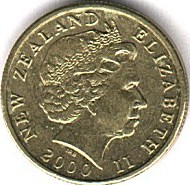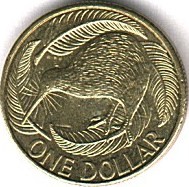New Zealand one-dollar coin facts for kids
| New Zealand | |
| Value | 1.00 New Zealand dollars |
|---|---|
| Mass | 8.00 g |
| Diameter | 23.00 mm |
| Thickness | 2.74 mm |
| Edge | Intermittently milled |
| Composition | Copper-Aluminium-Nickel (Cu 92%, Al 6%, Ni 2%) |
| Years of minting | 1990–present |
| Catalog number | – |
| Obverse | |
 |
|
| Design | Elizabeth II, Queen of New Zealand |
| Designer | Ian Rank-Broadley |
| Design date | 1999 |
| Reverse | |
 |
|
| Design | A kiwi surrounded by silver fern fronds |
| Designer | Robert Maurice Conly |
| Design date | 1990 |
The New Zealand one-dollar coin ($1) is a special coin used in New Zealand. This coin, which we use today, first came out on 11 February 1991. It took the place of the old $1 paper money. Before this, there were some special "silver dollars" made for collecting, but you wouldn't usually see them in shops.
The $1 coin has a picture of a kiwi bird on its back side. This is why the New Zealand dollar is sometimes called the "Kiwi dollar"! People used this nickname even before the $1 coin was made.
Both the $1 and $2 coins in New Zealand are gold-coloured. Sometimes, if someone asks for a donation or an entry fee, they might say "gold coin please." This often means they want a $1 or $2 coin. A Koha is a traditional Māori gift or contribution.
Contents
New Zealand's One-Dollar Coin: A History
The $1 coin we use now replaced the $1 paper note. New Zealand changed its money system to use decimals on 10 July 1967. This meant using dollars and cents, like we do today.
The paper $1 note was replaced because it became too expensive to make. Also, paper money wears out quickly and needs to be replaced often. Coins last much longer! The first $1 and $2 coins were made in 1990, but they started being used in 1991. The paper $1 notes were then taken out of use later that year.
The new $1 coin was made from a mix of metals called aluminium bronze. It was 23.0 millimetres wide, 2.74 millimetres thick, and weighed 8.0 grams. The edge of the coin had eight parts that were alternately smooth and ridged.
Coin Designs Over Time
The back side of the coin, called the reverse, was designed by Robert Maurice Conly. It shows two important symbols of New Zealand: a kiwi bird looking to the left, surrounded by four leaves of the silver fern. The words "ONE DOLLAR" are also on this side.
The front side of the coin, called the obverse, first showed a picture of Queen Elizabeth II. This picture was designed by Raphael Maklouf. Around her portrait, it said "ELIZABETH II NEW ZEALAND" and the year the coin was made.
In 1999, the Queen's portrait on all new $1 coins was changed. A new picture by Ian Rank-Broadley was used. The words around her also changed to "NEW ZEALAND ELIZABETH II" followed by the year.
In 2006, the Reserve Bank of New Zealand made some changes to other coins. They made the 10c, 20c, and 50c coins smaller and lighter. They also stopped using the 5c coin. The $1 coin stayed the same size. This was because it was still quite new, and people liked using it. Also, it would have been expensive to change machines that only took $1 coins.
One interesting fact is that the New Zealand $1 coin and the old British £1 coin were very similar in size. This sometimes meant you could accidentally use a New Zealand $1 coin in the United Kingdom! However, this is no longer possible since a new £1 coin was released in 2017.
How Many Coins Were Made?
Here's a look at how many $1 coins were made in different years:
| Year | Coins minted |
|---|---|
| 1990 | 40,000,000 |
| 1991 | 10,000,000 |
| 2000 | 5,000,000 |
| 2002 | 8,000,000 |
| 2003 | 4,000,000 |
| 2004 | 2,700,000 |
| 2005 | 2,000,000 |
| 2008 | 11,000,000 |
| 2010 | 10,000,000 |
| 2013 | 10,080,000 |
| 2015 | 10,000,000 |
| 2019 | 12,200,000 |
| Total | 125,740,000 |
The Future of the New Zealand Dollar Coin
After Queen Elizabeth II passed away in September 2022, the Reserve Bank of New Zealand said that new coins will eventually feature King Charles III. However, they will use up all the coins they already have first. This means it might be several years before you see new coins with King Charles III on them.
See also

